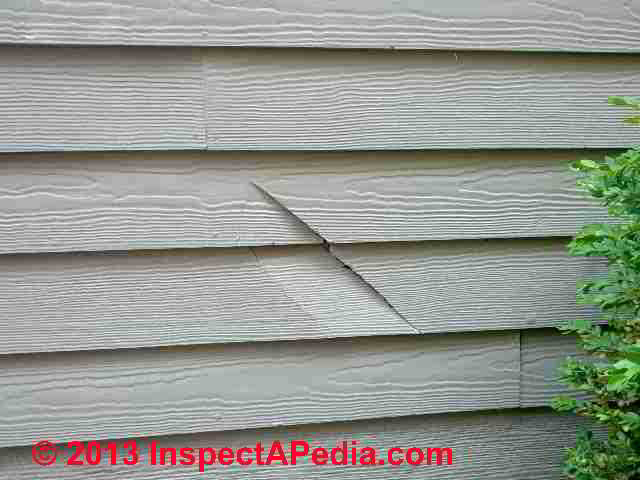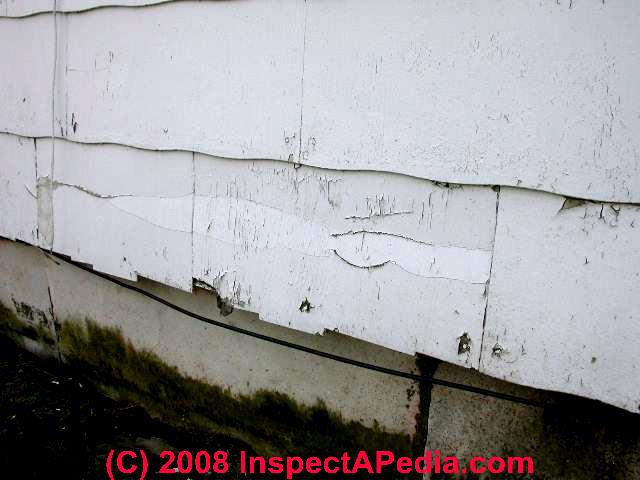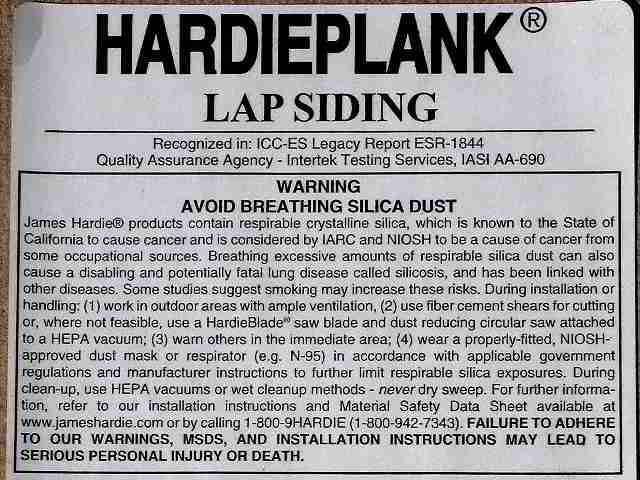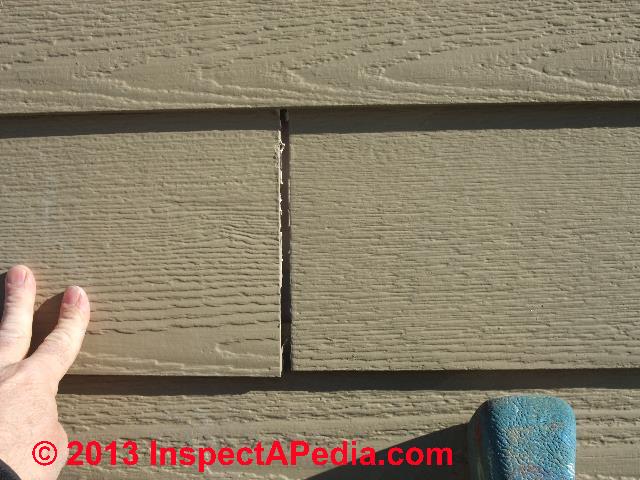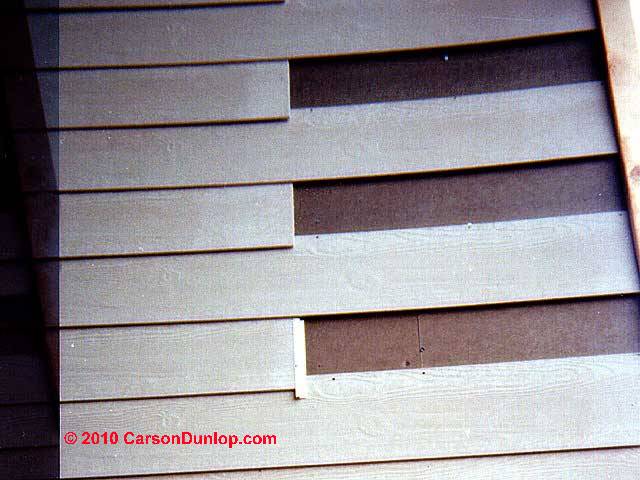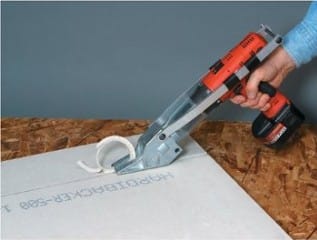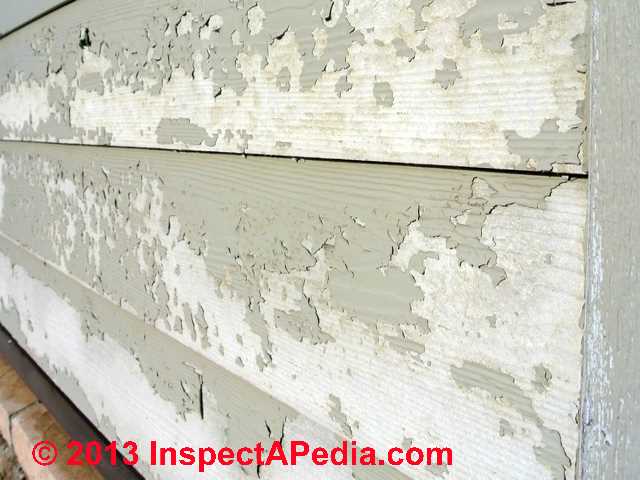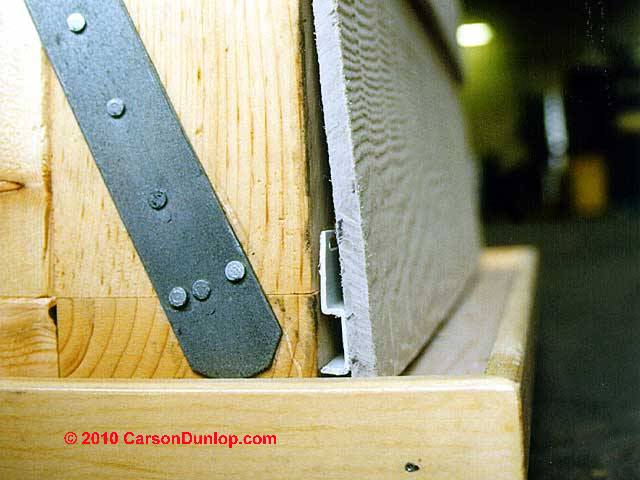 Fiber-Cement Siding
Fiber-Cement Siding
- POST a QUESTION or COMMENT about installing fiber cement siding on buildings
Fiber cement siding home page.
This article discusses the selection and best-practices installation of fiber cement building siding products.
In a series of companion pages we provide details about the properties of various fiber cement siding products from the major manufacturers, how to identify fiber cement siding, how to install fiber cement siding including guidelines for gaps, clearances, nailing schedules, end and cut sealing, siding joint or abutment caulking, painting or staining.
We include fiber cement siding installation specifications, repair and maintenance and painting recommendations, and fiber cement siding manufacturer identification guides.
InspectAPedia tolerates no conflicts of interest. We have no relationship with advertisers, products, or services discussed at this website.
- Daniel Friedman, Publisher/Editor/Author - See WHO ARE WE?
Fiber Cement Siding: Product Choices, Installation Details
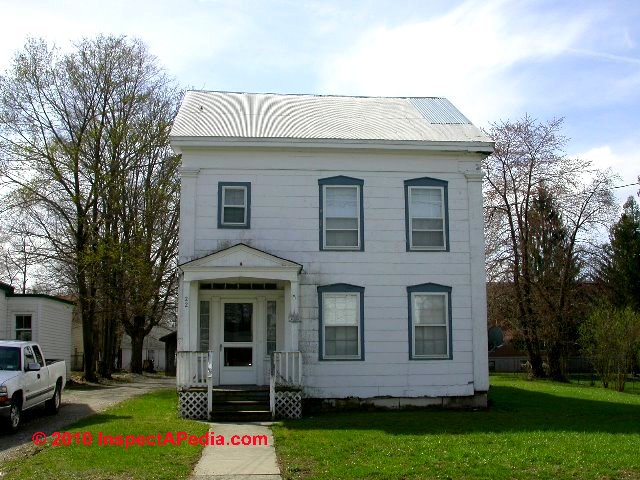
This article series discusses best practices construction details for building exteriors, including water and air barriers, building flashing products & installation, wood siding material choices & installation, vinyl siding, stucco exteriors, building trim, exterior caulks and sealants, exterior building adhesives, and choices and application of exterior finishes on buildings: paints, stains.
Article Contents
- ASBESTOS in FIBER CEMENT SIDING?
- FIBER CEMENT SIDING PERFORMANCE & DEFECTS
- FIBER CEMENT SIDING NAILING DETAILS
- FIBER CEMENT SIDING CUTTING
- FIBER CEMENT SIDING PAINTING
See our complete list of fiber cement siding types, defects, repairs, manufacturers & manuals at MORE READING found at the end of this page.
Photo above: older asbestos cement or fiber cement shingles on a New York yome. [Click to enlarge any image]
Page top photo of fiber cement clapboard installation courtesy of Carson Dunlop Associates, a Toronto home inspection, education & report writing tool company [ carsondunlop.com ].
Does Fiber Cement Siding Contain Asbestos?
No.
Modern fiber cement siding discussed here and sold in North America (and probably Europe, Austraila, & New Zealand) is not an asbestos product and does not contain asbestos.
I say "probably" because of an alert for some Chinese made products.
There may, however, be other health concerns related to silica or other dust produced by power saws or similar cutting operations in the modern material.
Details about the older generation of fiber cement products, asbestos cement wall shingles and modern fiber cement wall shingles are discussed separately
Also ASBESTOS & FIBER CEMENT ROOFING
and also CORRUGATED ROOFING. CD Johnston also makes an interesting distinction between fiber-reinforced cements and concretes and fibercement products, noting that "The fiber content in these composites is much lower than in fibercement composites". [3]
Performance of Fiber Cement Building Siding
Many synthetic alternatives to wood siding have fallen short either on aesthetics or durability.
Modern fiber cement siding, while surely outperforming other materials like hardboard siding, is not impervious to mechanical damage, coating or paint failures, and a shrinkage and siding butt-joint cosmetic or leak issue, as our photo shows above and as discussed
at SIDING, FIBER CEMENT DEFECTS .
"Modern" fiber cement building cladding has been around for more than 60 years, if we include its early form, cement-asbestos shingles such as those on the home shown below left (Dover Plains, NY).
Following the development of concern for asbestos safety, fiber cement shingles continue in production, but using reinforcing and filler materials other than asbestos.
Fiber-cement [in plank form], unlike it's shingle ancestors, is one of the newest entries into the siding field and holds promise in that the material can be fashioned to resemble almost any exterior cladding, holds paint well, and is essentially impervious to decay, insects, UV radiation, and fire.
Older fiber cement and asbestos-cement wall siding (photo at left) is vulnerable to impact damage. Repairs must be done with care to avoid breaking additional siding shingles when removing and replacing the bad ones.
Modern fiber-cement siding is made up primarily of Portland cement, sand, and wood fibers.
It is chemically similar to older asbestos sidings but contains no asbestos, glass fibers, or formaldehyde.
Watch out: : for silica dust hazards:
while it does not contain asbestos, modern fiber cement siding products do, however, produce a very fine silica dust when cut with a saw or abrasive blade, which, if inhaled, can cause silicosis and other serious respiratory problems.
Above is the English language portion of the silica dust warning included with Hardieplank® lap siding. The company, James Hardie, gives this advice in both English and in Spanish [click to see an enlarged image].
Fiber-cement boards are extremely straight and rigid when held edgewise, but they are much heavier than wood—about 20 pounds for a 12-foot length of 8-1/4 -inch siding.
They are flexible along the flat dimension, however, so any lumps in a wavy framing job will tend to telegraph through the siding.
Any fiber cement material is fairly brittle and, if not handled carefully, can crack or break. We found in particular that when picking up long lap siding boards it was critical to keep the board on edge - that is, its upper or lower horizontal edge is carried parallel to the ground.
Carrying a long fiber cement board "on the flat" risks breakage.
Shrinkage & Gaps in Fiber Cement Siding - watch out for "wet" fiber cement siding right from the manufacturer and watch out for siding butt joint gaps as wet siding shrinks
Modern fiber cement siding products are also very dimensionally stable and resist shrinking and swelling, cupping, warping, and splitting.
Warranties for fiber cement siding run
from 30 to 50 years depending on the manufacturer and
specific configuration. Fiber cement siding is cost-competitive with vinyl
and hardboard siding and significantly less expensive than
premium wood sidings. [Best Practices Guide to Residential Construction, by Steven Bliss,]
Watch out: based on our own field experience we do not quite agree with Steve Bliss's note above. We have seen serious shrinking in both counterfeit fiber cement siding and right from the factory James Hardieplank fiber cement siding that we inspected and tested in 2012 and 2013 - DJF.
The manufacturer told us that the material must be kept dry and "not installed" if the contractor thinks it's "wet". But from the service rep with whom we spoke we could not get the slightest definition of "wet" or "too much moisture" or "dry" fiber cement siding. [6]
- For details about the cause & cure of butt joint gaps in modern fiber cement siding, such as the unsightly lap siding gap shown above)
see SIDING, FIBER CEMENT GAPS - For details about examining fiber cement siding products for moisture level
see SIDING, FIBER CEMENT MOISTURE LEVELS
Styles and Sizes of Fiber Cement Siding Products
Fiber-cement is available in a wide array of styles and finishes modeled after other materials ranging from horizontal wood siding to vertical sidings, wood shakes, bricks, and stones.
The wood patterns are generally available either smooth or wood-grained and most are available factory-primed or finished as well as unfinished.
Our photo (left) is interesting because it shows two nearly-identical fiber cement wall shingles. The shingle on the right is a new replacement product that does not contain asbestos, while the shingle on the left is an older cousin that contains asbestos.
A clue to the presence of new fiber cement shingles on this home might be the observation that the shingle on the right is coated only with the factory primer while that on the left has been painted a few times.
See ASBESTOS CEMENT SIDING for details.
Fiber-cement horizontal siding planks are typically 5-1/4 to 12-1/4 inches wide by 12 feet long and are designed for a 1-1/2 inch overlap.
Vertical siding panels measure 4x8, 4x9, or 4x10 feet, and shake and shingle panels are typically 16x48 inches.
The thickness of most siding materials is 1-5/inch. Smooth and textured soffit and trim boards are also available.
Fiber-cement soffit material is typically 1/4-inch and most trim stock is 7/16-inch thick, but manufacturers have recently introduced thicker profiles (see section on fiber-cement trim, page 34 in Best Construction).
...
Lap-Siding Fiber Cement Board Installation Instructions
Fiber-cement siding products install similarly to the wood products they imitate. They can go over wood-based sheathings or rigid foam, but they must be nailed or screwed directly to studs or 2x blocking. Fasteners should penetrate solid wood by 1 to 1-1/4 inches, depending on the manufacturer’s specifications.
Our fiber cement siding photo (left) courtesy of Carson Dunlop Associates, shows the product in end view (trade show booth installation detail) and includes the first-course bottom spacer behind the fiber cement clapboard.
The 12 foot long fiber-cement planks can be held edgewise by a single person, but the boards may break in two or deform if picked up flat. One person can install a plank by driving a single nail near its center to hold it in place against guide nails driven into the sheathing to mark the upper edge.
Manufacturers recommend leaving 1/8-inch between board ends and window casings and trim and caulking with a paintable 100% acrylic latex caulk.
Butt joints between two planks can be either lightly butted and painted over or gapped 1/8-inch and caulked.
Manufacturers recommend priming cut ends on site if the joints are not being caulked. As with other siding products, leave at least 1/2-inch clear at step and other flashings so the bottom edge does not soak up water.
...
Nailing & Butt-Joint Flashing Details for Nailing Fiber Cement Siding
Our photo (left) shows a pre-fabricated plastic flashing device intended to be inserted at the butt-joints of both wood-based fiberboard siding and also where gaps have become a problem, at fiber-cement wall siding.
(Photo courtesy Carson Dunlop Associates, a Toronto home inspection, education, and report writing tool engineering firm).
H-flashing that can be used at lap siding butt joints in both of these siding families is discussed in detail
at SIDING, FIBER CEMENT GAP CURES.
Also see SIDING, FIBER CEMENT GAP & CAULK SPECS.
Fiber-cement siding should be nailed directly to studs with nail penetration into solid wood of 1 to 1-1/4-inches, depending on the manufacturer’s specifications.
Pre drilling is required within 1/4inch of an edge or near sharp angles or other fragile shapes to avoid cracking. Pre drilling may also be required when nailing through foam sheathing to avoid cracking the siding.
Manufacturers require a hot-dipped galvanized or stainless-steel siding nail (or roofing nail for blind nailing) that should be driven flush with the surface.
Overdriving of nails can cause the material to shatter around the nail, weakening its holding power and, with some products, voiding the warranty. Staples and clip-head nails tend to penetrate too far, but coil nailers with adjustable depth-of drive work well. Some contractors hand-nail the siding to avoid problems.
Given the longevity of the siding, a long lasting corrosion-resistant nail is recommended. If fastening to metal studs, use corrosion-resistant pneumatic pins or self-tapping bugle-head screws.
...
Standard Nailing in Fiber Cement Siding
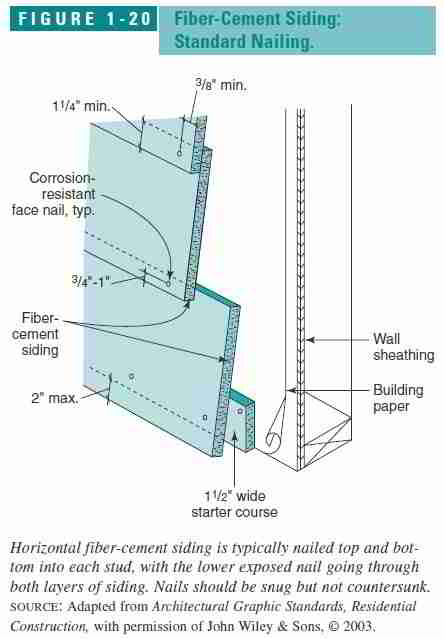
In most installations, horizontal fiber-cement siding is nailed top and bottom into each stud, with the lower exposed nail going through both layers of siding (see Figure 1-20).
Butt joints should lie over studs. This is the most durable installation. Color-matched galvanized nails are available for the exposed nails on prefinished sidings.
...
Blind Nailing Procedure for Fiber Cement Siding
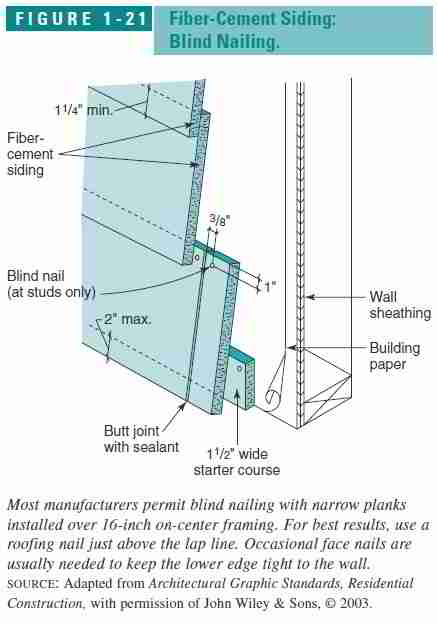
Recommendations for blind nailing fiber cement siding products vary among manufacturers, but most permit “blind nailing” with siding planks less than 8-1/4-inches wide installed over 16-inch on center framing.
In this siding nailing technique, the fasteners are hidden just above the lap line of the overlapping plank and put a slight curve in the siding, pulling it tight to the wall. Roofing nails work well because of their large heads (see Figure 1-21 at left).
An occasional extra face nail may still be required to hold the lower edge tight to the wall where there is a bump or bulge in the framing. Since the lower edges remain unsecured, blind nailing is not suitable for high-wind areas.
See also
SIDING, FIBER CEMENT NAILING DEFECTS - Mistakes in nailing fiber cement siding.
Reader Question: 1/4-inch gaps between siding boards and next course?
How tight should the 5.25" (4" reveal) lap boards rest one on top of the other?
For a new install, I would expect the bottom of the board to lay flat on the top of the one under it, however, on a job, I am seeing boards with 1/4"+ gaps, but I can't find any literature saying what the max should be. - Mike 3/13/2013
Reply:
Mike,
Normally the lower edges of lap siding are touching to 1/16" on the top edge of the course below.
The siding you describe sounds as if it is loose or nailed oddly and improperly.
Given this loose installation, I'd take a look also at the nail lines to be sure that the courses were lapped according to the manufacturer's specifications.
Question: OK to use Ring Shank Nails with James Hardie fiber cement siding?
2018/03/08 Elan said:
HI I have heard mixed things on whether to use ring shank or smooth nails. James Hardie does not seem to specify. I like the idea of using ring shank for the added holding power, but am afraid of getting blowout.
Reply:
Elan
As ring-shank nails have more holding power they're often used (as are spiral-shanked nails and sometimes cement-coated nails) in siding applications.
James Hardie has this nail specification, using HZ5 Lap siding as an example
BLIND NAILING
Nails - Wood Framing
- Siding nail (0.09 in. shank x 0.221 in. HD x 2 in. long)
- 11ga. roofing nail (0.121 in. shank x 0.371 in. HD x 1.25 in. long)
James Hardie recommends the use of quality, hot-dipped galvanized nails in that document.
In James Hardie's Best Practices guide p. 25 the company says:
TIP: Stainless steel fasteners are recommended when installing James Hardie products.
James Hardie DOES recommend ring-shanked nails in the company's UK HardiePlank siding installation guide
Fixings for HardiePlank® Cladding
The cladding does not require pre-drilling and can simply be nailed or screwed to the battens. Fixings must have suitable corrosion protection for the intended application. Check with your engineer where additional consideration must be made.
Nails: Ring shank nails of at least 50mm × 2.8mm and diameter head of 6.5mm. These nails should be manufactured according to EN10230-12000.
Where 50 × 25mm battens are installed on blockwork, ring shank nails of 2.65 × 30mm, 8mm can be used with hand nailing.
Screws: Screws must be a minimum of 35mm long, 4mm diameter shank with 8mm diameter self-embedding head.
...
Cutting Methods for Fiber Cement Siding
Watch out: When cut with a diamond abrasive blade in a circular saw, fiber-cement creates a cloud of very fine silica dust which can cause silicosis and other serious respiratory problems.
Ordinary carbide-tipped blades produce less dust but wear out within a few hours compared to a few months for abrasive blades. In the last few years, manufacturers have responded with specialized diamond tipped blades and tools, making the work easier and safer.
The new fiber-cement blades cut smoother, create less dust, and outlast ordinary carbide blades. When used with the new dust-collecting saws designed for fiber-cement, cutting is safe and effective.
Many contractors also use electric shears such as the fiber cement shears produced by Malco Products. (Photo above courtesy Malco Products.)
Fiber cement cutting shears are similar to a sheet-metal nibbler but specially adapted for fiber-cement. These make a clean cut with little dust, but are not as fast as a circular saw and cannot cut through multiple boards at once. Scoring and snapping, as for drywall, is also an option for quick cuts where a crisp edge is not needed.
...
Finishing & Painting Details for Fiber Cement Siding
After installation, small dents or chips can be filled with any cementious patching compound. Before priming or applying the top coat to pre primed material, wipe away any dust from cutting with a damp cloth or sponge or lightly hose down the siding and allow it to dry thoroughly.
If the siding has been hosed down or power washed (unprimed siding only), allow at least two sunny days before priming. Painting should be completed within 90 days of installation to avoid deterioration of the surface from prolonged exposure to water.
For unprimed siding, manufacturers recommend an alkali-resistant, 100% acrylic primer specifically approved by the paint supplier for fiber-cement. Back-priming is not necessary; in fact, some manufacturers recommend against back-priming so any trapped moisture can dry from the back of the siding.
For the top coat, use a 100% acrylic latex paint. Because fiber-cement is dimensionally stable and largely inert, it holds paint well. Estimates range from 7 to 15 years for a quality paint job. Some of the prefinished products carry 15-year warranties on the finish.
Our photo (above left) of paint failure on a fiber-cement siding installation was provided by BC home inspector Hugh Cairns. Mr. Cairns is a Canadian home inspector located in B.C. and is an occasional contributor to InspectAPedia.com.
- Details about fiber cement siding paint selection & application are
at FIBER CEMENT SIDING PAINTS.
...
Chinese Manufacturers of Fiber Cement Siding
The illustration below is of a Chinese-made fiber cement siding product produced by Ningbo Yihe Greenboard Co., Ltd. While we have no specific complaint about this product, it and similar fiber-cement siding board products may add to difficulties in determining the origin and manufacture of various modern fiber-cement siding products.
The siding above is described by the Zhejiang manufacturer as:
- Quality-assured by ISO9001:2008 quality control system,and the boards are tested by SGS authority.
- Standard board sizes are:1220mm x 2440mm or 1200mm x 2400mm; and the standard thickness varies from 6mm to 18mm; for other sizes or thickness, the company can also customize siding dimensions up to a maximum width of 1220mm & a maximum length is 3000mm.
Watch out: That fiber cement siding is available from a variety of sources is evident from the list below. In addition, some our investigations of fiber cement siding failures (paint or coating failures, shrinkage, gaps discussed
and SIDING, FIBER CEMENT DEFECTS
led to an assertion by U.S. manufacturers that even though the homeowner had been told that a U.S. product was being installed (Hardieplank for example) in fact the manufacturer has told the homeowner that it was not their product.
In a conversation with James Hardie about Hardieplank and in a second one with Certainteed as well as field inspection of Hardieplank confirmed to be the case: building owners may have been paying a premium for counterfeit products and more, when there is a product failure they may have no recourse. [Personal communications, DJF with both companies, April - June 2013].
Identification of Chinese-Made Fiber Cement siding may be aided by this additional detail offered by the manufacturer: beginning in 2012, fiber cement siding from the supplier listed above is provided only with a smooth finish. The embossed wood grain patterns that were used before 2012 have, according to the manufacturer "been mostly destroyed".
However in the spring of 2013 the company contacted us with this update
While,unfortunately,since last year we had already stopped producing the Fiber Cement Siding Boards in wood-grain pattern. Because, most of the moulding plate that are used for wood-grain embossing were broken. And now, we can only produce common Fiber Cement Siding Boards without wood-grain embossing.
Details about identification of the manufacturer of fiber cement siding products are
...
FC Siding Installation Guides & Best Practices
Moved to
JAMES HARDIE HARDIEPLANK INSTALLATION GUIDES & MANUALS
and
...
List of Fiber-Cement Siding Brands, Sources, Manufacturers and Trim Suppliers
This list is now at FIBER CEMENT PRODUCT MANUFACTURERS
- - Portions of this article were adapted with permission from Best Practices Guide to Residential Construction (Steve Bliss, J Wiley & Sons) .
Fiber Cement Siding & Roofing Standards
Question:
2016/10/28 Laura Smith said:
What are the particular certifications that a Manufacturer must have in North America to sell Fibre cement products ( ie Miami Dade for wind)
Reply:
I'm not aware of manufacturer certifications for fiber cement siding nor have I seen separate wind-damage-resistance standards for fiber cement products; however for use in buildings some building products may be required to meet various building, ASTM, or UL or other code standards such as for fire safety.
However siding and rain screen products themselves are indeed produced to standards such as we discuss
at FIBER CEMENT PRODUCT STANDARDS where you'll find a detailed answer to your question.
...
Reader Comments, Questions & Answers About The Article Above
Below you will find questions and answers previously posted on this page at its page bottom reader comment box.
Reader Q&A - also see RECOMMENDED ARTICLES & FAQs
Rport on Hardiepanel Sierra 8 vertical siding on barn and horse shelters.
I have the Hardiepanel Sierra 8 vertical siding on my barn and horse shelters.
I is certainly not what I expected. Some of it was the factory primed, some was primed and painted after installation, some was primed and painted before installation.
Some was nailed with the JH recommened nails and caulked with the recommended 50 year caulk. Some was screwed and caulked and some was screwed with rubber gaskets.
The gaskets have held the best. It doesn't matter if there is Tyvek and 2X8 solid walls that it is fastened to or 2X6s spaces horizontally at 24 inches O.C.or standard 2x4 house framing with the Tyvek.
Regardless of what we have done it fails. It absorbs moisture during the spring and summer and dries out during the later fall and winter.
The swelling and shrinking around the nails breaks the product up and negates the holding power of the nails causing the panels to fall off if we have a storm or a blow of any sort. Heck we've had a panel come down during good weather. It just works the nails through the siding with the environmental moisture changes.
The siding effervesces, crumbles, cracks, splits in layers, swells, shrinks and disintegrates.
The size of the gaps between the panels change with the season so much that the caulk doesn't stand a chance of keeping a nice seal, so I end up with water coming through the siding which is fortunately stopped by the Tyvek, but after awhle the wind working through the seem causes perforations in the Tyvek.
The siding was installed around 2003 by a builder according to instructions at the time. He griped about the panels cracking while the nails were starting to drive in and tried pre-drilling holes which didn't work either.
The product sounded fabulous: no rot, no worries of termites, FIRE proof (biggie to me), 4-legged termites wouldn't chew on the shelters, and it would last my lifetime. All I needed to do was caulk and paint every so often.
I'm done caulking and I'm done painting and I'm done buying new sheets to replace the sheets that have fallen off and broken up. The trim is even worse!
I had an area rep. out last year. He was pretty quiet when he saw all the failure and then told me I need to get ahold of the main office.
I'm pretty sure they know there is a problem with the material and hopefully the formula has gotten better in the last year because I've replaced enough panels over the years to know that it hasn't improved enough to last anywhere near 30 years, much less the 50 year warranty that it was bought with back in the early 2000s.
I guess it is back to T1-11 if I want the siding to stay on the barn in one piece. So glad we opted for brick on the house and metal on the hay shed! - On 2019-10-24
by Judy
-
Do I use ring shank or smooth nails in fiber cement siding?
HI I have heard mixed things on whether to use ring shank or smooth nails. James Hardie does not seem to specify.
I like the idea of using ring shank for the added holding power, but am afraid of getting blowout. - On 2018-03-08 by Elan
Reply by (mod) - James Hardie recommendations for nailing FC Siding
Elan
As ring-shank nails have more holding power they're often used (as are spiral-shanked nails and sometimes cement-coated nails) in siding applications.
James Hardie has this nail specification, using HZ5 Lap siding as an example
BLIND NAILING
Nails - Wood Framing
• Siding nail (0.09 in. shank x 0.221 in. HD x 2 in. long)
• 11ga. roofing nail (0.121 in. shank x 0.371 in. HD x 1.25 in. long)
James Hardie recommends the use of quality, hot-dipped galvanized nails in that document.
In James Hardie's Best Practices guide p. 25 the company says:
TIP: Stainless steel fasteners are recommended when installing James Hardie products.
James Hardie DOES recommend ring-shanked nails in the company's UK HardiePlank siding installation guide
https://www.jameshardie.co.uk/import/Documents/HardiePlank%20Installation%20Guide.pdf
Fixings for HardiePlank® Cladding The cladding does not require pre-drilling and can simply be nailed or screwed to the battens. Fixings must have suitable corrosion protection for the intended application.Check with your engineer where additional consideration must be made. Nails: Ring shank nails of at least 50mm × 2.8mm and diameter head of 6.5mm.
These nails should be manufactured according to EN10230-12000. Where 50 × 25mm battens are installed on blockwork, ring shank nails of 2.65 × 30mm, 8mm can be used with hand nailing.
Screws: Screws must be a minimum of 35mm long, 4mm diameter shank with 8mm diameter self-embedding head.
Idenitifing Hardieplank vs. LP Smartside or Masonite siding shrinkage at butt joints?
The picture of the shrinkage at butt joints is not Hardieplank. Its LP Smartside or Masonite. Not a fiber cement product. The woodgrain looks nothing like Hardie. On 2017-09-05 by Stephen S Identifying
Reply by (mod) - sales invoice confirmed Hardieplank Identification in siding shrinkage case
Thank you for the comments, Stephen.
We're dedicated to accuracy and appreciate your taking the time to write.
I'm not sure which photo you refer-to, so I will give some links to additional articles in this series where more FC siding photos and identification keys are provided. With exception of a plastic lookalike included for comparison, the siding discussed on this page is fiber cement material.
Older HardiePlank products are discussed at JAMES HARDIEPLANK® FC SIDING https://inspectapedia.com/exterior/James_Hardiplank_Siding.php
At SIDING, FIBER CEMENT IDENTIFICATION - are several FC siding identification keys and photographs including information from the manufacturers.
At SIDING, FIBER CEMENT MOISTURE LEVELS are photos from one of those investigations at which we had the sales invoice, the original wrapping materials, still factory-sealed from the manufacturer, manufacturers imprint on packaging and labels, as well as identification markings all confirming that product identification.
So I'm pretty confident that we have correctly identified fiber cement siding and that we know the difference between a fiber cement product and some of the superficially-look-alike wood products such as hardboard siding made from wood fibres.
At SIDING, FIBER CEMENT GAPS https://inspectapedia.com/exterior/Fiber_Cement_Siding_Gaps.php are more photos of several brands of FC siding jobs that we investigated, including HardieBoard Nichiha Fiber and in one case "counterfeit" HardieBoard made in China, all fiber cement and all with gap issues and moisture issues.
Finally, at SIDING HARDBOARD https://inspectapedia.com/exterior/Hardboard_Siding_Guide.php you will find a description of wood-product based hardboard siding such as Masonite products and other brands, and we take care to distinguish these from fiber cement products.
Please take a look and fire-away with your suggestions for clarification, photos (via the page bottom CONTACT link) or whatever you're willing to contribute on these topics.
Thanks again, Daniel.
.
Looking for experience using hardi soffit as an external cladding on a metal frame industrial building
I wondered if anyone has experience using hardi soffit as an external cladding on a metal frame industrial building where air-flow through the building is to be promoted by keeping >50% surface area open to the environment. the building will house a Waste Water Treatment Plant.
I'm thinking the steel columns would have equivalent of Nelson studs over which the pre-drilled hardi soffit would be applied in a horizontal direction. comments would be appreciated at dmackinnon00@gmail.com. I live in Ucluelet, BC - On 2017-03-21 by Don MacKinnon
Reply by (mod) -
Interesting question, perhaps a reader will respond
Certifications that a Manufacturer must have in North America to sell Fibre cement products
What are the particular certifications that a Manufacturer must have in North America to sell Fibre cement products ( ie Miami Dade for wind) - On 2016-10-28 by Laura Smith
Reply by (mod) - ASTM C1186 - 08(2012) Standard Specification for Flat Fiber-Cement Sheets
I'm not aware of manufacturer certifications; however for use in buildings some building products may be required to meet various building or UL or other code standards such as for fire safety.
Examples: ASTM C1186 - 08(2012) Standard Specification for Flat Fiber-Cement Sheets
Abstract: This specification covers either untextured or surface textured non-asbestos fiber-cement flat sheets intended for exterior applications such as claddings, facades, curtain walls, soffits, and so forth.This specification does not apply to asbestos-cement flat sheets, gypsum-based boards or particle boards, discrete non-asbestos fiber-cement interior substrate sheets, fiber-mat reinforced non-asbestos cement interior substrate sheets, or cement-bonded particleboards. Flat sheets covered here are divided into two types according to their intended application, and four grades according to their flexural strengths.
Type A sheets are intended for exterior applications subjected to the direct action of sun, rain, or snow, while
Type B sheets are intended for exterior applications not subjected to the direct action of sun, rain, or snow.
Sheets shall adhere to the following mechanical and physical requirements: flexural strength, density, dimension (nominal length, width, and thickness, squareness, and edge straightness), finish, and color.
ASTM also describes this important committee:
Committee C17 on Fiber-Reinforced Cement Products
Staff Manager: Mary Mikolaloveski 610-832-9678
ASTM Committee C17 on Fiber-Reinforced Cement Products was formed in 1946. C17 meets twice a year, in June and December, with about 20 members attending over two days of technical meetings.
The Committee, with a membership of approximately 60, currently has jurisdiction of over 65 standards, published in the Annual Book of ASTM Standards, Volume 04.05. C17 has 5 technical subcommittees that maintain jurisdiction over these standards.
Information on this subcommittee structure and C17's portfolio of approved standards and Work Items under construction are available from the List of Subcommittees, Standards and Work Items below.These standards have and continue to play a preeminent role in all aspects relating to asbestos and non-asbestos fiber reinforced cement roofing, siding, flat sheets, corrugated sheets, pipe and similar products deriving their essential properties from fiber and cement.
There are other ASTM standards pertaining to fiber cement siding and fiber cement products such as
ASTM C1185-08(2012) Standard Test Methods for Sampling and Testing Non-Asbestos Fiber-Cement Flat Sheet, Roofing and Siding Shingles, and Clapboards
ASTM E2394-11 Standard Practice for Maintenance, Renovation, and Repair of Installed Asbestos Cement Products
ASTM C725-90(2014) Standard Specification for Semidense Mineral Fiber Siding
ASTM C1154-06(2011) Standard Terminology for Non-Asbestos Fiber-Reinforced Cement Products
ASTM C1459-04(2014) Standard Specification for Performance of Non-Asbestos Fiber-Reinforced Cement Shake, Shingle, and Slate Roofing Systems
ASTM C223-98(2014) Standard Specification for Asbestos-Cement Siding
ASTM C1225-08(2012) Standard Specification for Fiber-Cement Roofing Shingles, Shakes, and Slates
ASTM C221-98(2014) Standard Specification for Corrugated Asbestos-Cement Sheets
ASTM C1530/C1530M-04(2014) Standard Specification for Non-Asbestos Fiber-Cement Roofing Shakes, Shingles, and Slates with Designed Varying Profiles and Thicknesses
ASTM C1530/C1530M-04(2014) Standard Specification for Non-Asbestos Fiber-Cement Roofing Shakes, Shingles, and Slates with Designed Varying Profiles and Thicknesses
ASTM C1325-14 Standard Specification for Non-Asbestos Fiber-Mat Reinforced Cementitious Backer Units
You'll see, using the above ASTM fiber cement product standards as an example, that the standards pertain to the properties of the product, not a "certification of the manufacturer"
Thanks for asking. I'll add the above to the article as it may help other readers.
This article series includes excerpts or adaptations from Best Practices Guide to Residential Construction , by Steven Bliss, courtesy of Wiley & Sons.
...
Continue reading at SIDING, FIBER CEMENT GAP & CAULK SPECS or select a topic from the closely-related articles below, or see the complete ARTICLE INDEX.
Or see these
Recommended Articles
- ASBESTOS & FIBER CEMENT ROOFING - home
- ASBESTOS ROOFING / SIDING DUST
- CERTAINTEED WeatherBoards™
- CHINESE FIBER CEMENT SIDING
- FIBER CEMENT PRODUCT STANDARDS
- FIBER CEMENT ROOF SHINGLE ASBESTOS TEST RESULTS
- FIBER CEMENT SIDING - home
- FIBER CEMENT SIDING DEFECTS - home
- FIBER CEMENT SHINGLE DEFECT DIAGNOSIS
- FIBER CEMENT SHINGLE CUTTING TOOLS
- FIBER CEMENT SHINGLE REPAIRS
- FIBER CEMENT SIDING BUCKLING
- FIBER CEMENT SIDING BUTT JOINT CURLING
- FIBER CEMENT SIDING BUTT JOINT GAPS & SHRINKAGE
- FIBER CEMENT SIDING BUTT JOINT BACK FLASHING OMITTED
- FIBER CEMENT SIDING CAULKING ERRORS
- FIBER CEMENT SIDING COEFFICIENTS of EXPANSION
- FIBER CEMENT SIDING CURL / LIFT DEFECTS
- FIBER CEMENT SIDING DEFECT DIAGNOSTIC QUESTIONS
- FIBER CEMENT SIDING END CUT PRIMER COAT
- FIBER CEMENT SIDING GAPS
- FIBER CEMENT SIDING GAP & CAULK SPECS
- FIBER CEMENT SIDING GAP CURE
- FIBER CEMENT SIDING NAILING DEFECTS
- FIBER CEMENT SIDING LOOSE, NAILING FAILURES
- FIBER CEMENT SIDING NAILING ERRORS
- FIBER CEMENT SIDING SPLITS
- FIBER CEMENT SIDING STARTER STRIPS
- GROUND CLEARANCE DISTANCE for SIDING
- HOUSEWRAP DAMAGE
- HOMEOWNER COMMENTS on FIBER CEMENT SIDING
- TEMPERATURE EFFECTS on FIBER CEMENT SIDING
- FIBER CEMENT SIDING IDENTIFICATION
- FIBER CEMENT SIDING MANUFACTURERS & Manuals
- FIBER CEMENT SIDING MAINTENANCE
- FIBER CEMENT SIDING MOISTURE ABSORPTION
- FIBER CEMENT SIDING MOISTURE LEVELS
- FIBER CEMENT SIDING PAINTS
- FIBER CEMENT SIDING REMOVAL
- FIBER CEMENT SIDING REPAIRS
- JAMES HARDIEPLANK® FC SIDING
- JAMES HARDIE HARDIEPLANK INSTALLATION GUIDES & MANUALS
- NICHIHA ™ FIBER CEMENT SIDING FIELD REPORT
- FIBER CEMENT PRODUCT STANDARDS
- FIBER CEMENT ROOF SHINGLE ASBESTOS TEST RESULTS
- SIDING HARDBOARD IDENTIFICATION & CLAIMS
- SIDING CLEARANCE TO GROUND
Suggested citation for this web page
FIBER CEMENT SIDING - home - at InspectApedia.com - online encyclopedia of building & environmental inspection, testing, diagnosis, repair, & problem prevention advice.
Or see this
INDEX to RELATED ARTICLES: ARTICLE INDEX to BUILDING SIDING
Or use the SEARCH BOX found below to Ask a Question or Search InspectApedia
Ask a Question or Search InspectApedia
Try the search box just below, or if you prefer, post a question or comment in the Comments box below and we will respond promptly.
Search the InspectApedia website
Note: appearance of your Comment below may be delayed: if your comment contains an image, photograph, web link, or text that looks to the software as if it might be a web link, your posting will appear after it has been approved by a moderator. Apologies for the delay.
Only one image can be added per comment but you can post as many comments, and therefore images, as you like.
You will not receive a notification when a response to your question has been posted.
Please bookmark this page to make it easy for you to check back for our response.
IF above you see "Comment Form is loading comments..." then COMMENT BOX - countable.ca / bawkbox.com IS NOT WORKING.
In any case you are welcome to send an email directly to us at InspectApedia.com at editor@inspectApedia.com
We'll reply to you directly. Please help us help you by noting, in your email, the URL of the InspectApedia page where you wanted to comment.
Citations & References
In addition to any citations in the article above, a full list is available on request.
- Best Practices Guide to Residential Construction, by Steven Bliss. John Wiley & Sons, 2006. ISBN-10: 0471648361, ISBN-13: 978-0471648369, Hardcover: 320 pages, available from Amazon.com and also Wiley.com. See our book review of this publication.
- [3] Johnston, Colin D., Fiber-reinforced cements and concretes. Vol. 3., Taylor & Francis, (CRC Press) 2000. ISBN-10: 9056996940 ISBN-13: 978-9056996949, "This book summarizes and simplifies the results of a considerable body of research and practical experience with a wide range of fiber-reinforced cementitious composites."
- [4] Hugh Cairns, Subject 2 Home Inspections, is a professional home inspector in British Columbia, Canada, with offices in Kelowna B.C. and Kamloops B.C. He contributed the American Cemwood photo used at the top and within this article. Mr. Cairns can be contacted by telephone: 250-808-5777, or by email: okanagan@subject2homeinspections.com
- [5] Roger Xu, 徐银杰 (my Chinese name), Ningbo Yihe Greenboard Co., Ltd., No.189, Longzhen Road, Nongkenchang, Longshan Town, Cixi, Ningbo, Zhejiang China, Tel: 0086-574-63974118/83887668 Fax:0086-574-63974129/83887670 Mobile: 0086-15924317823; E-Mail: sales6@yhboard.com; Skype: dajiezi107, www.yhboard.com/en, personal correspondence 3/21/2013
- [6] James Hardieplank, personal communication with Daniel Friedman, 6/6/2013.
We called James Hardie to ask for guidance in determining just how much moisture was "too much" in Hardieplank siding, after observing that siding at a job arrived visibly wet from the factory even though still inside its original sealed plastic wrapping.
We called James Hardie's technical support line where a courteous representative told us he would refer us to Hardie's expert Benjaman Batres. Our call to Mr. Batres was returned by Stephanie (declined to give last name) from James Hardie's customer warranty service department.
Stephanie informed us that there are no moisture numbers, that it is not possible to measure moisture in fiber cement siding (utter nonsense!) and repeatedly advised "Just read our instructions" or "So file a claim".
Watch out: Don't count on much help from James Hardie's customer warranty department on siding shrinkage or butt joint gap concerns. Gaps at Hardieplank siding butt joints continue to appear in the Hardieplank installation. - [7] Eric Galow, Galow Homes, Lagrangeville, NY. Mr. Galow can be reached by email: ericgalow@gmail.com or by telephone: 914-474-6613. Mr. Galow specializes in residential construction including both new homes and repairs, renovations, and additions. Personal communication 3/20/2013.
- Paul Galow [Website galowconsulting.com ] - technical consultant on networking, LAN design, applications support. Galow Consulting Services [Website galowconsulting.com ] , 914-204-1749, email: paulgalow@galowconsulting.com
- John Rudy, Advantage Home Inspections, Flemington N.J. 08822 home inspector, 908-806- 6364, Home, Radon & Termite Inspections, Central & Parts of North New Jersey, email: jonadvantage1@yahoo.com
- Malco® Products siding tools are available from that company, including the SideSwiper II SRT2 discussed at Malco's website. Websearch 09/07/2010 http://malcoproducts.com/product/roofing-siding-gutter/siding-vinyl/siding-tools-vinyl/sideswiper-ii. Malco also produces other vinyl siding repair tools such as aprons, awls, hole punches, saw blades, and tools for for fiber cement products including power-assisted cutters
- [1] "James Hardie's Mesothelioma and Asbestos Legacy Continues, 2009", web search 03/01/2011, www.survivingmesothelioma.com
- [2] Killer Company, James Hardie Exposed, Matt Peacock, Harper Collins Australia, ISBN: 9780733325809; ISBN10: 0733325807
- [3] " Anyone else have HardiePlank siding on their house?", Early Retirement.org online blog, retrieved 1/14/2013, original source: http://www.early-retirement.org/forums/f27/anyone-else-have- HardiePlank-siding-on-their-house-19475.html
- [4] - DIY Chatroom, retrieved 1/17/2013, original source http://www.diychatroom.com/f2/ certainteed-weatherboard-vs-HardiePlank-4638/
- [5] Certainteed Weatherboard fiber cement siding and trim products - see certainteed.com/ or see certainteed.com/resources/sidingandtrimspecsheet.pdf
- [5a] "CertainTeed WeatherBoards™ Fiber Cement Siding Installation Manual", CertainTeed Corporation, 2012, CertainTeed Corporation, PO Box 880, Valley Forge PA 19482, Professional Help Line: 800-233-8990, Consumer Help Line: 800-782-8777, Website: Certainteed.com www.certainteed.com/resources/fc017.pdf retrieved 4/11/2013, [copy on file as Certainteed_Fiber_Cement_Siding_Install_fc017.pdf ]
- [5b] "Certainteed WeatherBoards™ Fiber Cement Siding Best Practices for Effective Job Site Management", CertainTeed Corporation, retrieved 4/15/13 original source: www.certainteed.com Copy on file as Certainteed_FC_Handling Brochure-Contractor_FC063.pdf
- [6] "Moisture Control in buildings: Putting Building Science in Green Building," Alex Wilson, Environmental Building News, Vol. 12. No. 5. [Good tutorial, "Moisture 101" outlining the physics of moisture movement in buildings and a good but incomplete list of general suggestions for moisture control - inadequate attention given to exterior conditions such as roof and surface drainage defects which are among the most-common sources of building moisture and water entry.--DJF]
- [7] J. Tibbets, "Green Houses", NCBI, retrieved 1/17/2013, original source: http://www.ncbi.nlm.nih.gov/pmc/articles/PMC1469482/
- [8] Gleeson et al, "Fiber Cement :Building Materials with Low Density Additives", U.S. Patent 8,182,606, B2 5/22/2012, [adding low volumes of volcanic ash & hollow ceramic microspheres to cellulose fiber-reinforced building materials.
- [9] Thanks to reader Marie Carr for James HardiePlank siding photograph and case history information. 06/01/2008
- [10] JamesHardie HardiePlank® Lap Siding information can be found at the company's web page on this material:
https://www.jameshardie.com/products_siding_hardieplankLapSiding.py - [11] "30-Year Limited Warranty HardiePlank® HZ5® Lap Siding, HardiePanel® HZ5® Vertical Siding,
HardieShingle® HZ5® Siding, HardieSoffit® HZ5® Panels", 1-800-9-HARDIE
10901 Elm Avenue Fontana, CA 92337, retrieved 1/18/2013, original source: https://www.jameshardie.com/pdf/warranty/hz5.pdf [copy on file as Hardieplank_Warranty_hz5.pdf] - [12] James Hardie Building Products, James Hardie CustomerLink™ Service Centre, 10 Colquhoun Street, Rosehill NSW 2142, Tel: 13 1103, Outside Australia 61 2 8837 4709, Fax: 1 800 818 819. Hardie has operations in Australia, Asia, Canada, Europe, New Zealand, United States, and the Philippines. The company is a significant producer of fiber cement siding and backerboard. Email: info@JamesHardie.com and Website https://www.jameshardie.com/
- JamesHardie Corporation, in the U.S. can be contacted at 26300 La Alameda, Suite 400, Mission Viejo, California 92691 - 1-888 J-HARDIE
1-888 542-7343 or by email to info@JamesHardie.com - [12b] "Technical Bulletin #9, Joint Flashing at Field Butt Joints", JamesHardie, retrieved 4/15/2013, original source: www.jameshardie.com, copy on file as James_Hardie_9-joint-flashing.pdf - quoting:
This Technical Bulletin is an explanation supporting the announcement made by James Hardie on September 8th, 2008 withdrawing its recommendation on the use of caulk at field butt joints for HardiePlank® lap siding. - [13] Instructions for application of HardiePlank lap siding can be found at https://www.jameshardie.com/products_siding_hardieplankLapSiding.py?openTab=jsnavLink4
- [14] "Homeowners Care and Maintenance Tips", 1-800-9-HARDIE
10901 Elm Avenue Fontana, CA 92337, included with product warranty information, retrieved 1/18/2013, original source: https://www.jameshardie.com/pdf/warranty/hz5.pdf [copy on file as Hardieplank_Warranty_hz5.pdf] - [15] "HardiePlank HZ5 Lap Siding Installation Requirements - Primed & Colorplus® Products",JamesHardie, November 2012, 1-800-9-HARDIE, 10901 Elm Avenue Fontana, CA 92337, retrieved 1/18/2013, original source: https://www.jameshardie.com/pdf/install/hardieplank-hz5.pdf, [copy on file as Hardieplank-hz5_Install.pdf]
- [16] Technical Bulletin #9, Joint Flashing at Field Butt Joints, James Hardie corporation, retrieved 1/19/2013, original source: https://www.jameshardie.com/pdf/technical-bulletins/9-joint-flashing.pdf
- [17] Technical Bulletin #17, Fastening Tips for HardiePlank® Lap Siding, James Hardie Corporation, retrieved 1/19/2013, original source: https://www.jameshardie.com/pdf/technical-bulletins/17 -fastening-tips-for%20-plank.pdf [copy on file]
- [18] Technical Bulletin #8, Expansion Characteristics of James Hardie® Siding Products, James Hardie Corporation, retrieved 1/19/2013, original source: https://www.jameshardie.com/pdf/technical-bulletins/8-expansion-characteristics.pdf [copy on file]
- MASONITE WOODRUF® ROOFING OR MASONITE OMNIWOOD® SIDING LAWSUIT SETTLEMENT NOTICE - PDF file
- In addition to citations & references found in this article, see the research citations given at the end of the related articles found at our suggested
CONTINUE READING or RECOMMENDED ARTICLES.
- Carson, Dunlop & Associates Ltd., 120 Carlton Street Suite 407, Toronto ON M5A 4K2. Tel: (416) 964-9415 1-800-268-7070 Email: info@carsondunlop.com. Alan Carson is a past president of ASHI, the American Society of Home Inspectors.
Thanks to Alan Carson and Bob Dunlop, for permission for InspectAPedia to use text excerpts from The HOME REFERENCE BOOK - the Encyclopedia of Homes and to use illustrations from The ILLUSTRATED HOME .
Carson Dunlop Associates provides extensive home inspection education and report writing material. In gratitude we provide links to tsome Carson Dunlop Associates products and services.


